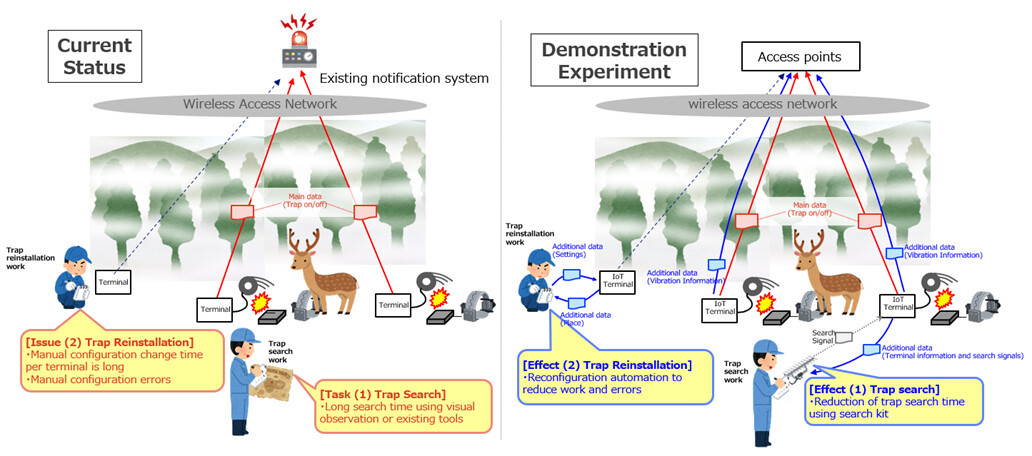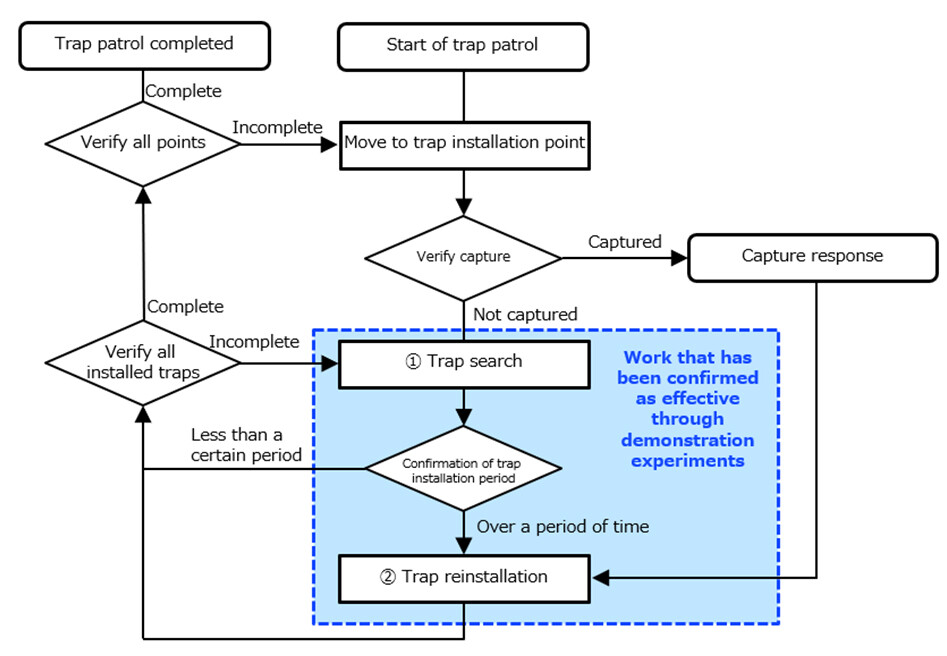Microsoft ends support for Internet Explorer on June 16, 2022.
We recommend using one of the browsers listed below.
- Microsoft Edge(Latest version)
- Mozilla Firefox(Latest version)
- Google Chrome(Latest version)
- Apple Safari(Latest version)
Please contact your browser provider for download and installation instructions.
March 22, 2024
NTT Corporation
VirtualTech Japan Inc.
Japan Multi Hunters Co., Ltd.
NPO Odawara Inoshikanet
Improve the efficiency of wildlife control in forests using IoT to solve issues in rural areas
Development of extended low-layer data communication technology to implement in IoT terminals
News Highlights:
- Extended low-layer data communication technology for IoT with simple a configuration utilizing the extended area of existing Layer 2 frame.
- Conducted PoC for wild bird and animal control using this technology and confirmed that the time required to patrol trap installation can be reduced to less than half.
Tokyo - March 22, 2024 - NTT Corporation (NTT), VirtualTech Japan Inc. (VirtualTech Japan), Japan Multi-Hunters Co., Ltd. (Japan Multi Hunters), and the non-profit organization Odawara Inoshikanet (Odawara Inoshikanet) have implemented NTT's extended low-layer data communication technology in outdoor IoT terminals provided by VirtualTech Japan in the forests of Odawara City, where wildlife control measures are being implemented by Japan Multi Hunters and Odawara Inoshikanet. By combining these IoT terminals with traps, NTT has confirmed that they are effective in improving the efficiency of daily trap patrols, which used to be dependent on the manual labor of hunters.
The results of this demonstration experiment are expected to improve the efficiency of wildlife control work by utilizing data acquired by various IoT terminals, to reduce damage to crops and people caused by wild animals such as boars, deer, and bears, which are becoming a problem in rural areas.
1. Background
The amount of crop damage caused by wild birds and animals in FY2022 was estimated to be 15.6 billion yen, of which 10.1 billion yen was caused by deer and wild boar, accounting for about 65% of the total*. In recent years, bears that appear in areas where people live have also caused many casualties, and this has become a major problem in rural areas where wild birds and animals coexist near humans. It has been pointed out that the increase in the number of wild birds and animals that appear in human living areas is related to environmental changes associated with climate change and the overpopulation of their natural habitat in forests. To create an environment where wild birds and animals and humans can coexist in harmony, the population of wild birds and animals in forests must be properly managed. In rural areas, wildlife control is mainly carried out by hunters belonging to local hunting clubs, but the aging of hunters, the shortage of hunter leaders, and the lack of efficient technology usage have been problems.
On the other hand, in terms of Internet of Things (IoT) technology, which is being implemented in society, various data (temperature, humidity, video, etc.) obtained from IoT terminals are being used to make various industries such as farms, factories, and distribution warehouses smarter, and the various data obtained from IoT terminals is being used for on-site operations. It is known that the settings and installation environment of IoT terminals affect the reliability of acquired data when analyzing and utilizing such data, and it is necessary to collect and utilize additional information (device model, installation location, network connection status, etc.) of IoT terminals and networks with limited resources under low load and efficient manner.
2. Details and results of the demonstration experiment
The following three main tasks: (A) Trap Installation, (B) Patrol, and (C) Capturing are required for wildlife control. While information on the area where traps are set (A) is generally shared within the hunting association, the actual points and number of traps to be set in the field are determined by the hunters who set the traps, based on the condition of the animal trails and feces of wild birds and animals at the site and the tracks. In addition, with the aging of hunters and the shortage of skilled personnel, it is necessary to reduce the burden on each hunter using technology to realize more sustainable measures against wild birds and animals by local hunters. To reduce the burden on hunters in the future, it will be necessary for many hunters to share the daily patrols conducted (B), and in some cases, a different hunter from the one who set the trap will be required to conduct the patrols. Therefore, a system is needed that allows hunters who do not know the details of the trap location to efficiently find traps at the trap location points in the mountains and forests, and to efficiently reinstall traps that have been inactive for a certain period. There have been reports of cases where off-the-shelf IoT terminals have been used to improve the efficiency of wildlife control, but there were operational issues such as the need to manually input settings for each trap and the complexity of IoT terminal settings (Figures 1, Figure 2).
- The flow of capturing wild birds and animals
- Set multiple traps in each trap area while going around the forest
- Daily patrols of the forest to check/collect/re-install the trap set by A
- Capture wild birds and animals
 Figure 1 Current Status of Wild Birds and Animal Damage and Image of Demonstration Experiment
Figure 1 Current Status of Wild Birds and Animal Damage and Image of Demonstration Experiment
 Figure 2 Hunting Point in the Forest (Left: Hunting point, right: Trap installation)
Figure 2 Hunting Point in the Forest (Left: Hunting point, right: Trap installation)
To evaluate the efficiency of wildlife operations, we examined the effects of efficiency improvements on (1) trap search and (2) trap re-installation during daily trap patrol operations (Figure 1, Figure 3, Figure 4). In this demonstration experiment, in the forest of Odawara City, where Odawara Inoshikanet and Japan Multi Hunters hunt, NTT implemented the extended low-layer data communication technology for IoT on the outdoor IoT terminal of VirtualTech Japan. A trap sensor and a trap search kit that displays the installation direction based on the location information sent from the trap sensor were prepared, and work efficiency was evaluated.
(1) In the evaluation of the trap search operation, we compared the time required for a subject who did not know the location of traps to find traps using the conventional technology (search using BLE beacons and existing applications) and this technology (NTT's proposed technology and search kit) under the condition that four trap sensors were set in the trap installation area. The average time to find all four traps with the conventional technology was 32 minutes and 56 seconds, whereas with the proposed technology, the average time was reduced to 14 minutes and 7 seconds, resulting in 57% improvement in work efficiency.
(2) In the evaluation of the time required to reinstall traps that have been inactive for a certain period, the time required to reinstall each trap was reduced to 1 minute and 30 seconds per trap using this technology, compared to 10 minutes per trap using the conventional manual method, resulting in an 85% increase in work efficiency.
 Figure 3 Daily Patrol Workflow
Figure 3 Daily Patrol Workflow
 Figure 4 Demonstration Experiment (Left: Trap search by hunters using the proposed technology, right: trap search kit)
Figure 4 Demonstration Experiment (Left: Trap search by hunters using the proposed technology, right: trap search kit)
3. Key points of technology
Development of extended low-layer data communication technology utilizing the extended area of Layer 2 frame
To efficiently collect additional information (device identifier, location, status, settings, etc.) of IoT terminals installed in various environments, it is necessary to have a low load on the network resources connected in the installation environment and a simple configuration that can be implemented even by IoT terminals with limited processing power. The extended low-layer data communication technology developed this time enables data communication by storing additional information in the extended area that developers have defined as implementable in the Layer 2 frame, which is specified in data communication, to collect additional information without affecting the main communication exchanged in Layer 3 frames or higher. This makes it possible to collect additional information without affecting the main communication over the Layer 3 frame (Figure 5). By implementing such a data communication function in a Layer 2 frame in an IoT terminal, it is possible to collect additional data when a network connection for general data communication over Layer 3 frames has not been established. In addition, by storing IoT terminal configuration data in the extended area and distributing it simultaneously, it is possible to automate the batch submission of settings for multiple IoT terminals connected to the network.
 Figure 5 Extended Low-Layer Data Communications Technology for IoT
Figure 5 Extended Low-Layer Data Communications Technology for IoT
4. Roles of each company
NTT: Provide extended low-layer data collection technology and evaluate in demonstration experiments
VirtualTech Japan: Provision of outdoor IoT sensor terminals and support for outdoor IoT terminal operation
Japan Multi Hunters: Evaluation and verification support in demonstration experiments
Odawara Inoshikanet: Provide a hunting ground
5. Outlook
Through this demonstration experiment, we were able to identify the possibilities of using IoT technology to provide concrete solutions to issues in rural areas, such as measures to control damage by wild birds and animals. We will continue to evaluate and conduct R&D for use cases where many IoT terminals are installed, such as smart farms, factories, and warehouses.
*"Nationwide Survey of Crop Damage by Wild Birds and Animals" by the Rural Development Bureau of MAFF.
URL:https://www.maff.go.jp/e/data/publish/attach/pdf/index-224.pdf
About NTT
NTT contributes to a sustainable society through the power of innovation. We are a leading global technology company providing services to consumers and businesses as a mobile operator, infrastructure, networks, applications, and consulting provider. Our offerings include digital business consulting, managed application services, workplace and cloud solutions, data center and edge computing, all supported by our deep global industry expertise. We are over $97B in revenue and 330,000 employees, with $3.6B in annual R&D investments. Our operations span across 80+ countries and regions, allowing us to serve clients in over 190 of them. We serve over 75% of Fortune Global 100 companies, thousands of other enterprise and government clients and millions of consumers.
Media contacts
NTT Information Network Laboratory Group
Public Relations
nttrd-pr@ml.ntt.com
VirtualTech Japan Inc..
Salles Department
sales@virtualtech.jp
Japan Multi Hunters Co., Ltd.
Salles Department
info@multi-hunters.jp
NPO Odawara Inoshikanet
Secretariat
burimori.p@gmail.com
Information is current as of the date of issue of the individual press release.
Please be advised that information may be outdated after that point.
NTT STORY
WEB media that thinks about the future with NTT









